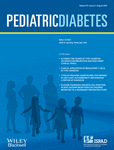Glucose tolerance and beta-cell function in islet autoantibody-positive children recruited to a secondary prevention study
Abstract
Aims
Children with type 1 diabetes (T1D) risk and islet autoantibodies are recruited to a secondary prevention study. The aims were to determine metabolic control in relation to human leukocyte antigen (HLA) genetic risk and islet autoantibodies in prepubertal children.
Methods
In 47 healthy children with GADA and at least one additional islet autoantibody, intravenous glucose tolerance test (IvGTT) and oral glucose tolerance test (OGTT) were performed 8–65 d apart. Hemoglobin A1c, plasma glucose as well as serum insulin and C-peptide were determined at fasting and during IvGTT and OGTT.
Results
All children aged median 5.1 (4.0–9.2) yr had autoantibodies to two to six of the beta-cell antigens GAD65, insulin, IA-2, and the three amino acid position 325 variants of the ZnT8 transporter. In total, 20/47 children showed impaired glucose metabolism. Decreased (≤30 μU/mL insulin) first-phase insulin response (FPIR) was found in 14/20 children while 11/20 had impaired glucose tolerance in the OGTT. Five children had both impaired glucose tolerance and FPIR ≤30 μU/mL insulin. Number and levels of autoantibodies were not associated with glucose metabolism, except for an increased frequency (p = 0.03) and level (p = 0.01) of ZnT8QA in children with impaired glucose metabolism. Among the children with impaired glucose metabolism, 13/20 had HLA-DQ2/8, compared to 9/27 of the children with normal glucose metabolism (p = 0.03).
Conclusion
Secondary prevention studies in children with islet autoantibodies are complicated by variability in baseline glucose metabolism. Evaluation of metabolic control with both IvGTT and OGTT is critical and should be taken into account before randomization. All currently available autoantibody tests should be analyzed, including ZnT8QA.




